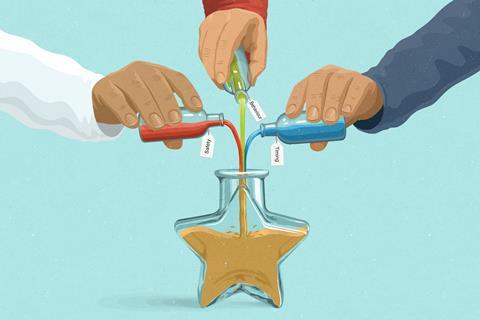Join teachers Laura and Hayley as they talk practically about teaching practical lessons

Former mentor and mentee, chemistry teachers Laura and Hayley recently caught up with each other to talk about practical lessons. Let’s find out what they have to say about setting up, behaviour, technicians and mess.
Former mentor and mentee, chemistry teachers Laura Scoular and Hayley Russell recently caught up with each other to talk about practical lessons. Let’s find out what they have to say about setting up, behaviour, technicians and mess.
LAURA: Hey, I can’t wait to show you our new ordering system for practical equipment. It’s fantastic.
HAYLEY: Ooh tell me more.
LAURA: The whole system is online. It is colour-coded and we order a week in advance.
HAYLEY: This sounds great. Quite like our system. It is so helpful for staying organised for all your classes’ experiments.
LAURA: I agree. I feel much more on-the-ball.
Managing practical experiments is a topic I’d have loved a session about when I was a student. It’s always a good topic for all levels of experience though. I know we are well into the term now and most teachers will have carried out many practicals but some extra hints and tips never go amiss.
LAURA: Managing practical experiments is a topic I’d have loved a session about when I was a student. It’s always a good topic for all levels of experience though. I know we are well into the term now and most teachers will have carried out many practicals but some extra hints and tips never go amiss.
HAYLEY: I totally agree. This is one area that can be tricky with new classes, even as an experienced teacher.
LAURA: Exactly. I remember it took me a long time to be comfortable with it.
HAYLEY: The first one is always daunting, but I try to get the Bunsen burners out as soon as I have begun forming positive relationships with my classes.
LAURA: I like this idea. Once they tackle that, they can try anything. I think making it fun and giving all S1 pupils the chance to get their ‘Bunsen burner licence’ is fun.
But to get to that point with any class, you have to be organised. It’s good to make sure you know what is supposed to happen throughout the experiment. Also, how to work any apparatus you haven’t used before.
HAYLEY: Practise it yourself before you teach it. The technicians or a colleague will be able to help you with anything you are unsure of.
LAURA: They can even suggest the best way to carry out the experiment and give you their top tips.
HAYLEY: This is true. I always ask biology and physics specialists for fun add-ons when I am teaching BGE classes.
LAURA: I really like helping our students and probationers try out new stuff. You know me – I love the exciting things like cannon fire and screaming jelly baby.
Exciting experiments
Look no further than Exhibition chemistry for powerful demonstrations of classroom experiments: rsc.li/3OdGJsA
HAYLEY: Me too. I really enjoy teaching practical lessons and feel the pupils really benefit from hands-on learning. My favourites are methane bubbles and equilibrium colour changes. It does take a bit of work and practice to become comfortable with these though.
LAURA: I think a good explanation of a period of practical is helpful for teachers. How do you ensure you fit everything in without leaving a total mess?
When does a practical start?
HAYLEY: With practical periods, the lesson starts before the pupils even arrive.
LAURA: That’s a really good point. I make sure I have any demonstrations set up and any key kit out at each station. How is your classroom organised for practical work?
HAYLEY: It is similar to the way you guys have it at your school. I have 10 numbered stations around the room, and 10 numbered trays of equipment with all the basic apparatus that pupils use throughout the year. This way, the pupils always know exactly where to find things and have a responsibility for their own tray. All additional apparatus cupboards are labelled too.
LAURA: This is a really good way to do things. It means pupils can move quickly to their area and collect their own kit without you having to explain everything each time.
HAYLEY: But how do you get pupils started efficiently?
LAURA: It’s all about practice and experience. Even after many years of teaching, I get my timings wrong sometimes. You just have to reflect on what has gone wrong and change it for next time.
All my pupils are really good at following safety instructions.
Or they know the consequences for not!
HAYLEY: Exactly. Timing can be one of the biggest issues doing practical work.
Sometimes it is circumstances out of your control that cause problems too. Any small disturbance to your lesson can completely ruin the flow. Being fluid is best here and always having a back-up plan.
A major key to getting your practical right is to provide clear, concise instructions to your class.
LAURA: Exactly. Small, manageable instructions are so much better than one giant instruction.
Lots of our Powerpoints and notes have the method for the experiments on them. Pupils can check back while they are working rather than having to ask the teacher every few minutes.
HAYLEY: That is very important. For more challenging classes, I usually chunk it and we do a bit at a time together. It is also a good idea to share your method on the board.
LAURA: Visuals are so helpful in achieving the success criteria.
HAYLEY: I like to demonstrate what the pupils will be doing before I let them loose.
LAURA: Letting them loose can be daunting at first, but very seldom does something go wrong. If it does, it is very important to stay calm.
HAYLEY: All my pupils know what to do if they spill something or break something. They are all really good at following safety instructions.
LAURA: Or they know the consequences for not!
HAYLEY: Ha ha, yes. Two warnings and then sitting down. Behaviour management is key here – and there are some great articles to help you with strategies. It is also important to share health and safety information with your classes too.
HAYLEY: Two warnings and then sitting down. Behaviour management is key here – this series can help with strategies: rsc.li/3tABRUP. It is also important to share health and safety information with your classes too.
LAURA: And always double-check for allergies to any chemicals and things like latex when using gloves or balloons.
How do you make sure they’re learning?
HAYLEY: So, if it is a responsible class who can safely work independently, how do you facilitate successful learning?
LAURA: Personally I like to walk round while the class are working and ask them questions on what they are doing.
HAYLEY: Challenge questions are useful. It’s a good way to differentiate practical lessons too by engaging with smaller groups of pupils. You still need to observe the class as a whole though and it can be hard to strike that balance. If it is a trickier practical I manage from the front.
Once you have completed your practical I think it is just as important to manage the tidying up part.
LAURA: I know what you mean. I do this when we are testing a leaf for starch.
HAYLEY: It’s a difficult one to manage. There are so many chemicals. I split my pairs into A and B. Each person is given a different task to do after they have decided who is who.
LAURA: I do this too. Saves a crowd trying to get all the chemicals at once, and you can manage the alcohol better. It’s another strong differentiation method as you can swap the roles to observe each pupils’ skills.
HAYLEY: Once you have completed your practical I think it is just as important to manage the tidying up part.
Laura and Hayley’s top tips for perfect practicals
- Be prepared – practise the experiment before teaching it.
- Set some things up before pupils come in (if possible).
- Don’t be scared.
- Small manageable instructions work best
- Supervise constantly.
- Don’t panic if something goes wrong.
- Tidying up the mess is important.
- Match the energy of the class.
LAURA: This is especially true if you are sharing classrooms. There’s nothing worse than coming back into somebody else’s mess.
HAYLEY: I agree. It also teaches the pupils important life skills. My classes know that unless everything is back where they found it, and all my side benches are dry, they don’t get to pack up and leave.
LAURA: These are good routines to implement from the beginning of the year.
HAYLEY: Pupils love coming to science for practical work and will talk about the cool experiments for ages afterwards. Once I know my class well and have gauged their ability and understanding, I try to add some additional context to practicals. For example, turning flame testing into potion school.
LAURA: Although it might seem scary at first, practical work is a really enjoyable part of teaching – for everyone!
Tune into Hayley and Laura’s podcasts for tips on maintaining relationships and work-life balance.
Early career conversations

Essential advice for your first years of teaching in the science classroom, from a recent probationary teacher and her mentor
- 1
- 2
- 3
- 4
 Currently
reading
Currently
reading
Practical chat
- 6
- 7






















No comments yet